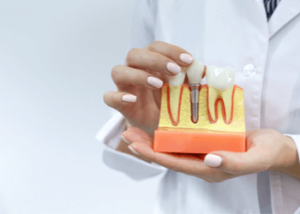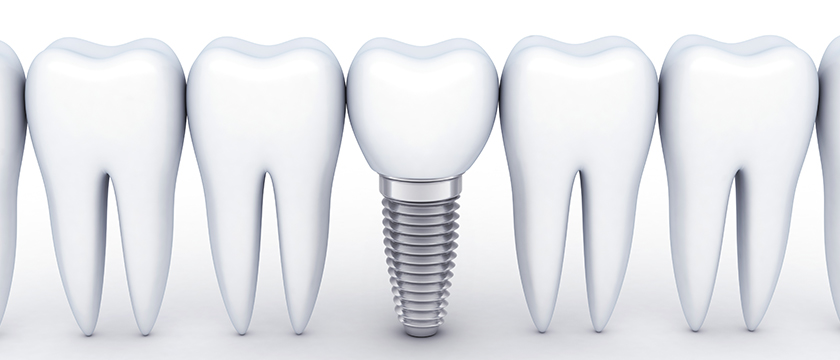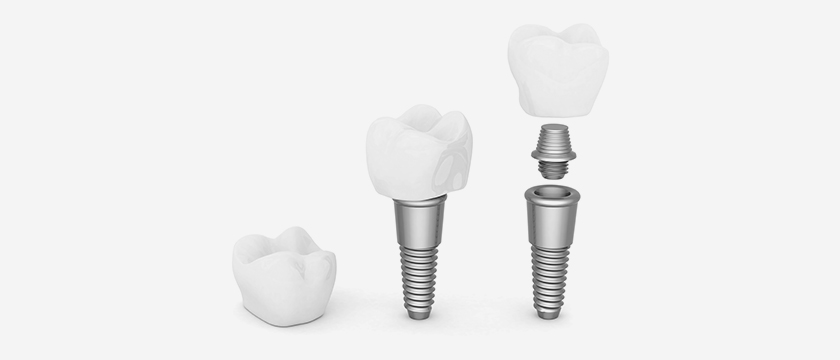In reality, most people who undergo dental implant treatment are surprised at just how easy and hassle-free the process is and once you understand the answer to the question ‘how do dental implants work?’ you’ll probably agree.
With this in mind, let’s take a closer look at how dental implants fit into the mouth and the benefits that they can bring.
What is a dental implant?
A dental implant is an artificial tooth root which (unlike other forms of missing tooth replacement) is anchored directly into the jaw during dental implant surgery. It is in fact the only treatment solution that provides a biological connection with bone tissue and in this respect, is very similar to natural teeth.
For this reason, dental implants have been proven to be a successful long-term option providing excellent retention for an artificial crown, dental bridge or dentures.
In essence, dental implants work in two main ways:
- They provide a solid foundation for a fixed prosthesis
- They ensure that bone volume is maintained
Let me explain…
Bone fusion
When a dental implant is anchored into the jaw at the missing tooth site, its biocompatibility means that any remaining bone tissue will migrate to the titanium structure and fuse with it. This is a vital part of the dental implant process which locks the dental implant into the jaw and is known as ‘osseointegration’.
Typically, osseointegration takes somewhere between 2-5 months to complete but after initial dental implant surgery, patients can go about their daily lives while this process naturally occurs.
Bone retention
The second important function is that it maintains bone retention.
So why is this important?
When teeth are missing and not restored immediately, the bone tissue that once supported the natural tooth root will start to absorb back into the body. Very similar to muscle, if it’s no longer in use, it starts to waste away (atrophy).
Moreover, when bone starts to reabsorb, the shape of the jaw and indeed the face changes shape. This can result in sunken features and sagging skin, making you appear older than your years.
 By restoring a missing tooth root with a titanium screw (dental implant) it restimulates any remaining bone tissue thus halting the bone loss. But with the inclusion of an artificial restoration, a dental implant can also restore facial features by ‘rounding out’ the face giving you a more youthful appearance.
By restoring a missing tooth root with a titanium screw (dental implant) it restimulates any remaining bone tissue thus halting the bone loss. But with the inclusion of an artificial restoration, a dental implant can also restore facial features by ‘rounding out’ the face giving you a more youthful appearance.
In essence, dental implants provide support for both the aesthetics and function of natural teeth. Once an implant has fully integrated into the bone, it can withstand a similar bite load to that of normal teeth.
Furthermore, once topped with a dental crown it creates a seamless aesthetic appearance that blends in perfectly with an existing smile.
Dental implant surgery
Of course, we can’t answer the question ‘how do dental implants work’ without talking about dental implant surgery. Understandably, this is the part of the process that most people dread. However, the onset of modern digital technology means that the majority of the surgical process can be virtually planned beforehand. Therefore, chair-side dental implant placement typically requires less anaesthetic and is faster than most other dental work.
Placing a dental implant
Essentially there are 3 components to a dental implant and these consist of:
- The implant itself – The titanium post or screw that is anchored into the jaw
- The abutment – This is a small collar that secures the artificial restoration to the implant
- The crown – This is the artificial tooth – the part that people notice when you smile.
There are several ways to place dental implants. They can be done conventionally, whereby
- An incision is made into the gum and the implant inserted into the jaw during initial dental implant surgery
- The gum is stitched back up and healing time is needed to allow for osseointegration to take place
- Once fused, the implant is uncovered once again and the abutment and permanent crown are attached,
Alternatively, implants can be placed using computer-guided (digital) technology where;
- A dental implant is placed through the gum and into the jaw using precise keyhole surgery and a temporary crown is also fitted that same day.
- Once the implant has fused with the bone, the temporary crown is removed and is replaced by a permanent crown
But what about immediate aftercare?
After any form of dental implant surgery, most patients report that taking a short course of over-the-counter painkillers is sufficient to manage any discomfort. In fact, after 7-14 days most people feel back to normal.
Dental implants – The long-term results
Because dental implants look and feel like natural teeth, long-term aftercare is relatively simple. Daily brushing and flossing coupled with regular dental check-ups are all that is required.In terms of longevity, the implant itself should last for the remainder of your life while the restoration (crown), typically has a shelf life of around 10-15 years so it may need replacing at some point.
That said, the longevity of dental implants far outweigh other forms of missing tooth replacements such as traditional dental bridges or dentures and as a result, can represent a solid long-term investment that can bring about an improved quality of life for many patients.
Hopefully, we have answered the question ‘how do dental implants work’ and more importantly what you can expect.
If you are considering undergoing dental implant treatment to replace missing teeth and would like to know more, then talk to the team at DDSS/DDII. We lead the way in digital dental implant surgery in Sydney. Call us for a consultation today.
DDII Gosford: (02) 8294 8656
DDSS Sydney: (02) 8294 5812






